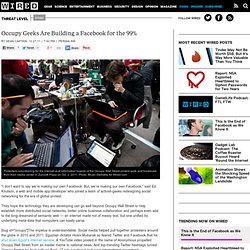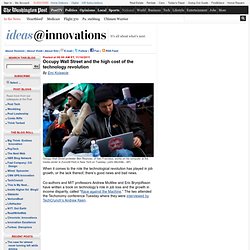

Occupy Geeks Are Building a Facebook for the 99% Protesters volunteering for the internet and information boards of the Occupy Wall Street protest work and broadcast from their media center in Zuccotti Plaza on Oct. 2, 2011.

Photo: Bryan Derballa for Wired.com “I don’t want to say we’re making our own Facebook. But, we’re making our own Facebook,” said Ed Knutson, a web and mobile app developer who joined a team of activist-geeks redesigning social networking for the era of global protest. They hope the technology they are developing can go well beyond Occupy Wall Street to help establish more distributed social networks, better online business collaboration and perhaps even add to the long-dreamed-of semantic web — an internet made not of messy text, but one unified by underlying meta-data that computers can easily parse. [bug id="occupy"]The impetus is understandable. Now it’s time for activists to move beyond other people’s social networks and build their own, according to Knutson. Occupy Wall Street. NYPD High Tech Meets Occupy Wall Street: The Science of Crowd Control.
Mobile phone streams Occupy Wall Street to the world. How Occupy Wall Street Occupied Twitter, Too. Television cameras and and newspapers have chronicled the so-called Occupy Wall Street protest movement as it has grown into a global phenomenon. But what has it looked like online? Thanks to a start-up called SocialFlow, and tons of Twitter data, we can actually see how the idea propagated through influential people and organizations, and across previously invisible conduits to permeate vast expanses of Twitter’s network. The first ever use of the #OccupyWallStreet hashtag was in an Adbusters blog post, way back on July 13, according to Gilad Lotan, SocialFlow’s head of research and development. The network of tweeters using the hashtag was small and sparse in the beginning, with no major media entities yet participating in the conversation.
Above is network graph showing all tweets containing the #OccupyWallStreet 10 days after the first use of the hashtag. Occupy Wall Street and the high cost of the technology revolution - Ideas@Innovations. Occupy Wall Street protester Ben Reynoso, of San Francisco, works on his computer at the media center in Zuccotti Park in New York on Tuesday.

(John Minchillo - AP) When it comes to the role the technological revolution has played in job growth, or the lack thereof, there’s good news and bad news. First, the bad news: If you haven’t guessed it already, the technology revolution is contributing to the rapidly growing income disparity between the haves and the have-nots. So, if you’re a member of the Occupy Wall Street crowd, you may have good reason to shake your fist at your Facebook page, iPad or GMail account, all of which were created by people well ensconced among the very top of the 1 percent of high-income earners. (Full disclosure: The Washington Post Co.’s chairman and chief executive, Donald E. That’s not to say technology hasn’t made life better in a variety of ways, allowing some to achieve wild success.
The solution is, in large part, education. (TechCrunch)